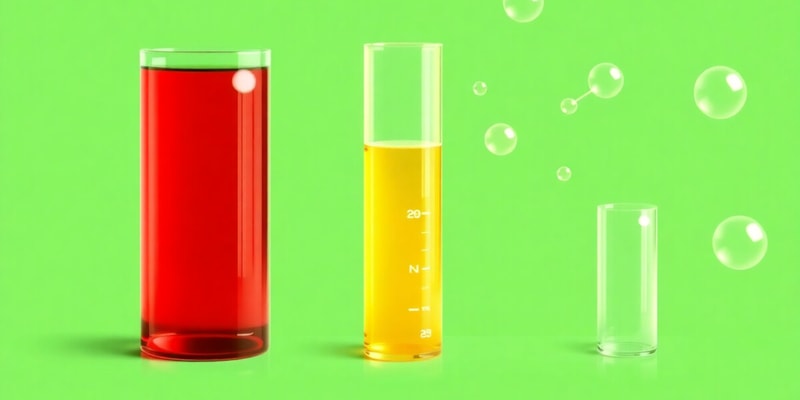Podcast
Questions and Answers
What is the value of ΔS° calculated from the reaction ATP → ADP + Pi at 37 °C?
What is the value of ΔS° calculated from the reaction ATP → ADP + Pi at 37 °C?
Which statement best describes the interpretation of ΔH° in the context of the ATP hydrolysis?
Which statement best describes the interpretation of ΔH° in the context of the ATP hydrolysis?
What temperature must be exceeded for the unfolding of the protein to become spontaneous?
What temperature must be exceeded for the unfolding of the protein to become spontaneous?
Which of the following correctly interprets the sign of ΔG in the hydrolysis of ATP?
Which of the following correctly interprets the sign of ΔG in the hydrolysis of ATP?
Signup and view all the answers
In the unfolding reaction of the protein, what is the significance of a positive ΔS°?
In the unfolding reaction of the protein, what is the significance of a positive ΔS°?
Signup and view all the answers
What does a negative ΔG imply about the position of equilibrium in the ATP hydrolysis reaction?
What does a negative ΔG imply about the position of equilibrium in the ATP hydrolysis reaction?
Signup and view all the answers
Given ΔH° and ΔS° for the unfolding of a protein, which value shows a greater contribution to the Gibbs free energy change?
Given ΔH° and ΔS° for the unfolding of a protein, which value shows a greater contribution to the Gibbs free energy change?
Signup and view all the answers
What key process is indicated by the reaction ATP → ADP + Pi?
What key process is indicated by the reaction ATP → ADP + Pi?
Signup and view all the answers
Study Notes
Gibbs Free Energy
- Gibbs Free Energy (ΔG) is a thermodynamic potential that can be used to predict the spontaneity of a process.
- A negative ΔG indicates a spontaneous process, while a positive ΔG indicates a non-spontaneous process.
- The equation for calculating Gibbs Free Energy is: ΔG = ΔH - TΔS
- ΔH is the enthalpy change, which is the heat absorbed or released during a reaction at constant pressure.
- ΔS is the entropy change, which is a measure of the disorder or randomness of the system.
- T is the temperature in Kelvin.
- A negative enthalpy change (ΔH) is favorable for a reaction, while a positive enthalpy change is unfavorable.
- A positive entropy change (ΔS) is favorable for a reaction, while a negative entropy change is unfavorable.
ATP Hydrolysis
- The hydrolysis of ATP to ADP and inorganic phosphate (Pi) is a spontaneous reaction.
- The standard Gibbs Free Energy change (ΔG°) for this reaction is -30.5 kJ/mol.
- The standard enthalpy change (ΔH°) for this reaction is -20.1 kJ/mol.
- The standard entropy change (ΔS°) can be calculated using the equation ΔG° = ΔH° - TΔS°
- ΔS° = 34 J/mol.
- The negative ΔG° value indicates that ATP hydrolysis is a spontaneous reaction.
- The negative ΔH° value indicates that the reaction is exothermic, meaning it releases heat.
- The positive ΔS° value indicates that the reaction increases the disorder of the system, which is consistent with the breakdown of a larger molecule into smaller molecules.
Protein Unfolding
- The unfolding of a folded protein is a process that requires energy.
- The standard enthalpy change (ΔH°) for protein unfolding is positive (250.8 kJ/mol) indicating that it is an endothermic process, requiring an input of heat.
- The standard entropy change (ΔS°) for protein unfolding is positive (752 J K−1 mol −1) indicating that the process results in an increase in disorder, consistent with the transition from a highly structured state to a more random state.
- Protein unfolding can be spontaneous at temperatures higher than a specific temperature, called the "unfolding temperature".
- The unfolding temperature is calculated by setting ΔG equal to zero and solving for temperature (T).
- For protein unfolding to be spontaneous, ΔG must be negative. This means that the entropic term (TΔS) must be greater than the enthalpic term (ΔH).
- As temperature increases, the effect of the entropic term (TΔS) becomes more significant, making protein unfolding more favorable.
Studying That Suits You
Use AI to generate personalized quizzes and flashcards to suit your learning preferences.
Related Documents
Description
Explore the concepts of Gibbs Free Energy and its role in predicting the spontaneity of chemical processes. Understand the importance of enthalpy and entropy changes as they relate to reactions like ATP hydrolysis. Test your knowledge on this essential thermodynamic principle.




